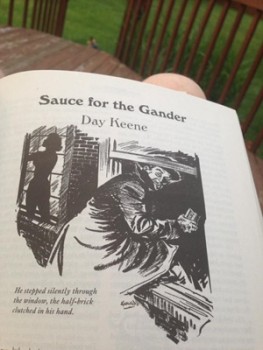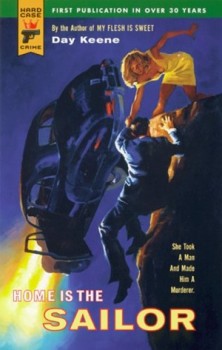A (Black) Gat in the Hand: Day Keene
 “You’re the second guy I’ve met within hours who seems to think a gat in the hand means a world by the tail.” – Phillip Marlowe in Raymond Chandler’s The Big Sleep
“You’re the second guy I’ve met within hours who seems to think a gat in the hand means a world by the tail.” – Phillip Marlowe in Raymond Chandler’s The Big Sleep
(Gat — Prohibition Era term for a gun. Shortened version of Gatling Gun)
“The Bloody Tide” appeared in the June, 1950 issue of Dime Detective. John D. MacDonald (my favorite writer) also appeared that month. Both men had stories in the May issue as well, with JDM scoring the cover.
The story opens with Charlie White being released from a Florida prison after serving three years for smuggling. He’s given some advice by another inmate on Death Row to go straight and stay on the outside. Get back to working on the water, even if it’s a menial job. Wouldn’t be much of a story if that’s how things go, though, would it?
White’s lover (not his wife) is waiting outside for him and drives him to a secluded beach cabin. He’s going to get back into that fast life again. While he was in jail, $1,000 had been deposited monthly into his bank account, presumably by the ‘big man,’ who he felt had cast him to the wolves.
‘The Devil came up behind me and pushed. To hell with Beth [his wife]. To hell with everything, I thought. To hell with trying to kill Senor Peso. In his way the guy had played square with me. Why should I try to goose into his grave an egg who laid so many golden pesos?’
“Nothing to Worry About” first appeared in the August, 1945 issue of Detective Tales. It also included stories by D.L. Champion, who you read about here, and William R. Cox, who I will be writing about soon.
Assistant State’s Attorney Brad Sorrell is a rising star in Chicago. He’d be a great candidate for the Senate, if not for Frances, his embarrassment of a drunken wife. She’s all that is holding back what he is certain would be a meteoric rise. Whereas his mistress, Evelyn, would be the perfect accompaniment. So, as he departs the plane, he is ready to carry out his flawless plan to remove this large obstacle.
 In his job, Sorrell argues that men should be given the death penalty for taking a life; and now he is going to do the latter. He realizes this – but he’s also uniquely qualified to beat the system.
In his job, Sorrell argues that men should be given the death penalty for taking a life; and now he is going to do the latter. He realizes this – but he’s also uniquely qualified to beat the system.
“No matter how brilliant a killer might be he was seldom, if ever, a match for the combined technical, executive and judicial branches of the law. Crime detection, trial, and judgement, has become akin to an exact science.”
Sorrell uses the knowledge he’s gained from his professional experiences and Keene does a nice job keeping the suspense up as we follow along, and the ending is pulp satisfying.
“Sauce for the Gander” was the first of only two stories that Keene landed in Black Mask, appearing in May, 1943. In it, a high school chemistry professor wants to kill his wife so he can be with his mistress. Sounds kind of familiar, eh? The central character comes across as less competent and qualified for his self-appointed task. I prefer the prior story, though this one also has a satisfying ending.
In June of 2008, I had read Keen’s novel, Home is the Sailor, the seventh book from Charles Ardai’s recently established Hard Case Crime (surely you read my Q&A with Charles here…). Seemed fitting to read it again as I worked on this essay. I didn’t remember much about it, other than I liked it and it had a cool cover (by Richard B. Farrell and Gregory Manchess).
I’ve never been particularly good at explaining the distinction between hardboiled and noir. A book can be one or both. Like the old definition of pornography (I know it when I see it), a reader usually recognizes a hardboiled story. Noir, to me, dealt with the darker side of human nature. Often the main character has some flaw or inherent character weakness that permeates the story. There is a palpable sense of ‘wrongness,’ whatever it may be. Noir is less about the crime or the story than it is about people and morality. Anywhoo…
 I wouldn’t call 1952’s Home is the Sailor hardboiled, but it is a very good noir. Swede Nelson has been saving his money and is ready to give up the sea, return to his hometown in Minnesota and buy a farm. It’s time to settle down. Gee…that would be a boring story. Fortunately, Keene has other plans for the big, strong, rowdy sailor. He wakes up in a bed in a motor court cottage, bloodied and missing his fifteen thousand dollars. He remembered cleaning up in an illegal dice game, being accused of cheating and fighting his way out of it all. Then, while drunk, a beautiful female named Corliss took charge of him.
I wouldn’t call 1952’s Home is the Sailor hardboiled, but it is a very good noir. Swede Nelson has been saving his money and is ready to give up the sea, return to his hometown in Minnesota and buy a farm. It’s time to settle down. Gee…that would be a boring story. Fortunately, Keene has other plans for the big, strong, rowdy sailor. He wakes up in a bed in a motor court cottage, bloodied and missing his fifteen thousand dollars. He remembered cleaning up in an illegal dice game, being accused of cheating and fighting his way out of it all. Then, while drunk, a beautiful female named Corliss took charge of him.
Corliss owns the motor court and events move along in typical noir fashion. There is a horrific event that shapes the rest of the story. It’s difficult to weather, but just keep moving along. A classic element of noir is that partners in some illicit activity become suspicious of each other. Keene is a master of fair play misdirection in this book (and he does give an early clue that I picked up on) and you wonder what exactly is going on as Swede and Corliss advance the plot. And things happen in a matter of days. There’s no break in this one.
The story is told from Nelson’s perspective, and he’s a heavy drinker, so the reader has to piece things together as he does. I think it works well enough.
I read far more hardboiled than noir. A movie example would be that I prefer Bogart’s The Maltese Falcon over In a Lonely Place. But I like this noir novel from Keene. I’m not completely sold on the wrap up, but overall, I’m as pleased with my second read as I was with my first.
Day Keene (real name, Gunard Hjerstedt was a stage actor in Chicago in the early twenties. When his friends, including Warner Brothers’ dependable gangster Barton MacLane, decided to try their luck in movies, Keene decided that writing, not acting was his calling.
Keene wrote solid, fast-moving, violent hardboiled pulp in the forties and into the early fifties. Then, he transitioned into the emerging paperback market, appearing under such imprints as Ace, Gold Medal and Avon. Keene’s stories have an intensity to them and often involve the protagonist under duress due to false accusations. Keene wrote nearly until his death in 1969 at the age of 65. In a bit of trivia, his novel Chautauqua, was adapted as the Elvis Presley movie, The Trouble With Girls.
I greatly respect the late Bill Crider and he was a Keene fan:
“Day Keene’s work was never less than professional, and it was always entertaining. If you don’t have him on your TBR list of ’50s paperbackers, you should certainly put him there.”
And the respected Ed Gorman adds, “He’s never less than readable and sometimes he’s almost a genius.”
Previous entries in the series:
With a (Black) Gat: George Harmon Coxe
With a (Black) Gat: Raoul Whitfield
With a (Black) Gat: Some Hard Boiled Anthologies
With a (Black) Gat: Frederick Nebel’s Donahue
A (Black) Gat in the Hand: Thomas Walsh
A (Black) Gat in the Hand: Black Mask – January, 1935
A (Black) Gat in the hand: Norbert Davis’ Ben Shaley
A (Black) Gat in the Hand: D.L. Champion’s Rex Sackler
A (Black) Gat in the Hand: Dime Detective – August, 1939
A (Black) Gat in the Hand: Back Deck Pulp #1
A (Black) Gat in the Hand: W.T. Ballard’s Bill Lennox
A (Black) Gat in the Hand: Black Mask – October, 1933 (next week)
Other hard-boiled related ramblings I’ve done at Black Gate:
A Century of John D. MacDonald
A Man Called Spade
Asimov’s The Caves of Steel
Carroll John Daly & the Birth of Hard Boiled
Cool & Lam are Back!
Erle Stanley Gardner on Mysteries
Gideon Lowry – Key West Private Eye
Glen Cook’s Garret – PI
Hard Boiled Holmes (my best pre-Black Gate work. Click on over!)
Hard Case Crime Q&A
John D. MacDonald – A Writer’s Writer
Lester Dent’s Master Plot Formula
The Maltese Falcon in Film
Michael Stone’s Streeter
Richard Diamond – Private Eye
Robert E. Howard Goes Hard boiled (Steve Harrison)
Shovel’s Painful Predicament
Bob Byrne’s ‘With a (Black) Gat’ appears weekly every Monday morning at Black Gate.
His ‘The Public Life of Sherlock Holmes’ column ran every Monday morning at Black Gate from March 2014 through March 2017 (still making an occasional return appearance!). He also organized Black Gate’s award-nominated ‘Discovering Robert E. Howard’ series.
He is a member of the Praed Street Irregulars, founded www.SolarPons.com (the only website dedicated to the ‘Sherlock Holmes of Praed Street’) and blogs about Holmes and other mystery matters at Almost Holmes.
He has contributed stories to The MX Book of New Sherlock Holmes Stories – Parts III, IV, V and VI.
And coming this summer, look for another Robert E. Howard series with an all star cast!